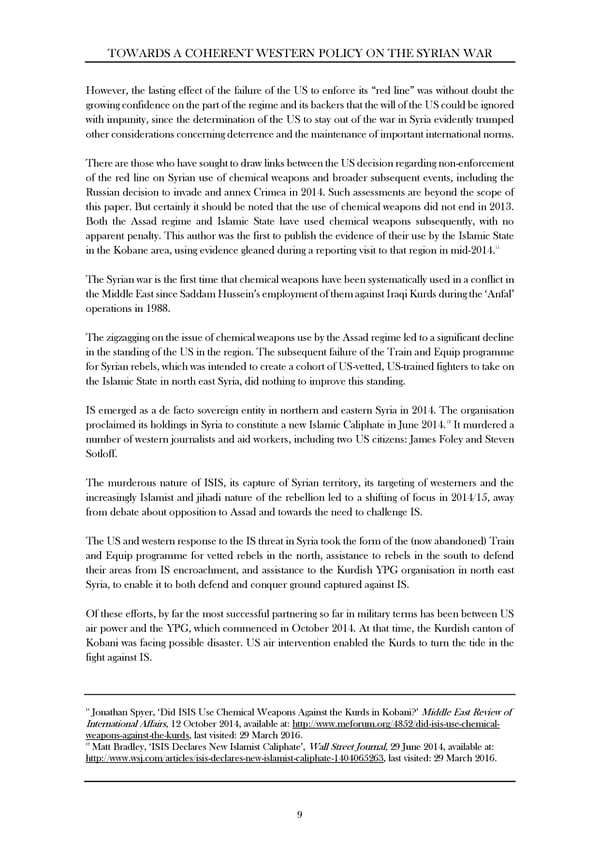TOWARDS A COHERENT WESTERN POLICY ON THE SYRIAN WAR However, the lasting effect of the failure of the US to enforce its “red line” was without doubt the growing confidence on the part of the regime and its backers that the will of the US could be ignored with impunity, since the determination of the US to stay out of the war in Syria evidently trumped other considerations concerning deterrence and the maintenance of important international norms. There are those who have sought to draw links between the US decision regarding non-enforcement of the red line on Syrian use of chemical weapons and broader subsequent events, including the Russian decision to invade and annex Crimea in 2014. Such assessments are beyond the scope of this paper. But certainly it should be noted that the use of chemical weapons did not end in 2013. Both the Assad regime and Islamic State have used chemical weapons subsequently, with no apparent penalty. This author was the first to publish the evidence of their use by the Islamic State 11 in the Kobane area, using evidence gleaned during a reporting visit to that region in mid-2014. The Syrian war is the first time that chemical weapons have been systematically used in a conflict in the Middle East since Saddam Hussein’s employment of them against Iraqi Kurds during the ‘Anfal’ operations in 1988. The zigzagging on the issue of chemical weapons use by the Assad regime led to a significant decline in the standing of the US in the region. The subsequent failure of the Train and Equip programme for Syrian rebels, which was intended to create a cohort of US-vetted, US-trained fighters to take on the Islamic State in north east Syria, did nothing to improve this standing. IS emerged as a de facto sovereign entity in northern and eastern Syria in 2014. The organisation proclaimed its holdings in Syria to constitute a new Islamic Caliphate in June 2014.12 It murdered a number of western journalists and aid workers, including two US citizens: James Foley and Steven Sotloff. The murderous nature of ISIS, its capture of Syrian territory, its targeting of westerners and the increasingly Islamist and jihadi nature of the rebellion led to a shifting of focus in 2014/15, away from debate about opposition to Assad and towards the need to challenge IS. The US and western response to the IS threat in Syria took the form of the (now abandoned) Train and Equip programme for vetted rebels in the north, assistance to rebels in the south to defend their areas from IS encroachment, and assistance to the Kurdish YPG organisation in north east Syria, to enable it to both defend and conquer ground captured against IS. Of these efforts, by far the most successful partnering so far in military terms has been between US air power and the YPG, which commenced in October 2014. At that time, the Kurdish canton of Kobani was facing possible disaster. US air intervention enabled the Kurds to turn the tide in the fight against IS. 11 Jonathan Spyer, ‘Did ISIS Use Chemical Weapons Against the Kurds in Kobani?’ Middle East Review of International Affairs, 12 October 2014, available at: http://www.meforum.org/4852/did-isis-use-chemical- weapons-against-the-kurds, last visited: 29 March 2016. 12 Matt Bradley, ‘ISIS Declares New Islamist Caliphate’, Wall Street Journal, 29 June 2014, available at: http://www.wsj.com/articles/isis-declares-new-islamist-caliphate-1404065263, last visited: 29 March 2016. 9
 Towards A Coherent Policy On The Syrian War Page 10 Page 12
Towards A Coherent Policy On The Syrian War Page 10 Page 12